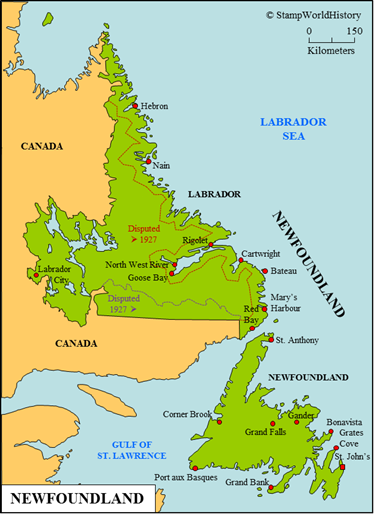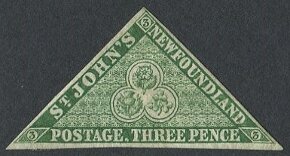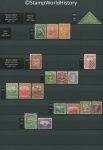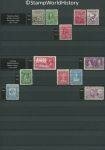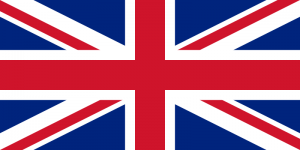
Newfoundland
Quick reference
General issues: British colony/Self government 1857-1907, British dominion/Self government 1907-1931, British dominion/Sovereign state 1931-1934, British colony 1934-1949
Country name on general issues: St. John’s Newfoundland, Newfoundland
Currency: 1 Shilling = 12 Pence 1857-1866, 1 Dollar = 100 Cents 1866-1949
Population: 122 000 in 1861, 348 000 in 1949
Political history Newfoundland
Newfoundland is located in North America. The political entity of Newfoundland consists of the island of Newfoundland and the mainland region of Labrador.
From first settlement to British possession
Prior to colonization, the island of Newfoundland was inhabited by the Amerindian Beothuk people, a people found exclusively on Newfoundland. The Norsemen were the first Europeans to establish temporary settlements on Newfoundland around 1 000 AD. The first step towards colonization was taken when the Italian explorer Giovanni Caboto – also referred to by his English name of John Cabot – explored Newfoundland in 1497. Caboto claimed Newfoundland for Britain, but the British did not settle the island. In the 16th century the waters around Newfoundland were the domain of Basque, British, French and Portuguese fishermen who set up seasonal camps on the island. Newfoundland was again claimed for Britain in 1583 and first settled in 1610. Although the first settlement was abandoned shortly after, more settlements followed, and by the mid 17th century the British had established a lasting presence on Newfoundland. The French also settled on Newfoundland in the 17th century. The French, however, were forced to cede their settlements in 1713 – after the Spanish War of Succession, which was an essentially European conflict that spread to the colonial possessions. The British thus gained possession of all of Newfoundland.
The Labrador boundary dispute
Labrador was part of the French colony of Canada and was, as such, ceded to the British in 1763. The ‘coast of Labrador’ was attached to Newfoundland in 1809. Just exactly how far inland the jurisdiction of Newfoundland extended would long be a matter of dispute between Newfoundland and Quebec – first the colony and then the province. It would take until 1927 before the boundaries were defined, after the dispute had been presented to the British Judicial Committee of the Privy Counsel – the court of final appeal for British possessions. Quebec accepted most of the ruling, but claims part of the territory awarded to Newfoundland until today. Labrador was – and is – sparsely populated. The indigenous peoples are of Amerindian and Inuit descent. Settlement by people of European descent was very limited, until mining of natural resources was developed in the mid 20th century.
From British colony to Canadian province
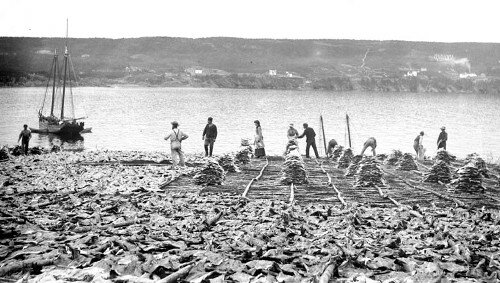
Fishery was, for a long time, the most important activity in Newfoundland. Cod was the main catch. Here salted cod is laid out to dry.
Newfoundland – having long been a proprietary colony – became a Crown colony in 1824.[1]Proprietary colonies were administered by private individuals, a Crown colony was administered by the British government. In 1855, Newfoundland gained self government. When, in 1867, the Canadian federation was formed, Newfoundland, by a vast majority, declined to join. In 1907, Newfoundland gained dominion status. As such, it became a sovereign state through the Act of Westminster in 1931. However, after major investments, the Newfoundland government had accrued debts to a level that – at the onset the Great Depression in 1929 – brought Newfoundland on the brink of default. In 1934, the status of dominion was suspended and Newfoundland reverted to being a British colony. After WWII, the question about the future of Newfoundland was again addressed. Eventually – by a narrow margin – Newfoundland voted to join the federation of Canada, which took effect in 1949. Newfoundland has, since then, been a province of Canada until today. The name of the province was changed to Newfoundland & Labrador in 2001.
Economy and demographics
The economy of Newfoundland has long been dominated by fishery – the waters around Newfoundland are considered to be among the richest in the Atlantic Ocean. In the late 19th century the economy was diversified into forestry and mining. In the 20th century the importance of fishing and forestry diminished. Currently, mining is still of significant importance, while oil production and tourism are being developed. In modern day Newfoundland, services are the most important sector. The vast majority of the population is of English, Irish or Scottish descent. The indigenous Beothuk suffered greatly from colonization and became extinct in the 1820’s. The indigenous peoples currently account for close to 4% of the population. Of the population, 92% lives on Newfoundland and 8% in Labrador.
Postal history Newfoundland
The first stamps were issued by Newfoundland in 1857. The one penny denomination shows the British crown and the four British heraldic flowers. A design, similar to that of the first issues of New Brunswick and Nova Scotia – also printed by Perkins, Bacon & Co in London – however, issued as a square rather than a diamond shape. The three penny denomination is of triangular shape and shows the heraldic flowers of England, Ireland and Scotland – the ancestral countries of the majority of the Newfoundland population. To my knowledge Cape of Good Hope is the only country that also issued stamps in triangular shape in this era – the Cape of Good Hope issues were, however, printed by De La Rue in London.
The stamps of Newfoundland are of attractive designs with themes of national interest and are printed by some of the most renowned printing houses – Perkins, Bacon & Co and De La Rue in London, and the American Bank Note Company in New York. For an inspiring discussion of the Newfoundland pictorials, please refer to the Newfoundland Pictorials post on the Big Blue 1840-1940 blog. The stamps of Newfoundland were superseded by those of the Dominion of Canada in 1949.
Album pages
← Previous page: Canadian Provinces - New BrunswickNext page: Canadian Provinces - Nova Scotia →

